A Simple Procedure for Fertilizing Cool-Season Lawns: Your guide to better results
RESOURCES - PUBLICATIONS
A Simple Procedure for Fertilizing Cool-Season Lawns: Your guide to better results
Content
Fertilizer Supplements Soil Nutrients..................................... 6
Understanding Fertilizer Application Math............................. 8
Measuring Square Footage for the Turfgrass Area ..................... 8
The Three Numbers on Fertilizer Bags...................................... 11
Calculate How Much Actual Nitrogen Is in Each Bag................. 12
What Did We Learn from These Calculations? .......................... 13
How Many Bags Will I Need to Purchase?................................ 13
Calibrating the Spreader to Evenly Distribute Fertilizer ............. 15
Two Commonly Used Spreaders............................................. 16
Customizing Your Process for the Perfect Application ..........20
Blow It Back in the Yard!......................................................... 21
Conclusion ............................................................................. 22
Worksheet .............................................................................. 24
Acknowledgements ............................................................... 26
Disclaimer.............................................................................. 26
A beautifully landscaped property with dark green grass moving in the breeze, beds of flowers in full bloom, and strategically placed shrubs can definitely set your property apart from the rest of the homes in the neighborhood. One thing’s for sure: people invest a great deal of time, work, and money into creating these beautiful landscapes!
That waving “sea” of turfgrass did not happen overnight. It required
• Planting the right turfgrass species and variety for the growing conditions
• Mowing the grass at the appropriate height
• Controlling annual and perennial weeds
• Watering when necessary
• Applying the right amount of fertilizer at the right time of year
These and other factors are crucial to achieving the healthy and eye-catching turfgrass areas that form the foundation of most landscapes that accentuate homes.
However, conflicting or confusing information can make it difficult to select and apply fertilizer effectively. Common challenges associated with fertilizer applications include:
• A misunderstanding that “more is better”
• Confusion about the appropriate amount of product to apply
• Uncertainty about the meaning of rate recommendations (such as, 1 pound of actual nitrogen per 1,000 square feet) and why following those recommendations is so important
• The need to calculate the amount of nutrients to apply
• Fertilizer packaging that does not provide instructions on how to set gate openings for specific spreader models
• Fertilizer labels that recommend unrealistic walking speeds or do not provide a speed
• Landscape factors that can affect even fertilizer applications, such as irregular lawn shapes, hills to walk up and down, and so on.
These challenges can increase the odds of spreading too little or too much fertilizer on turfgrass areas. This not only wastes money and time, but can also produce unhealthy turfgrass that is deficient in key nutrients. Unhealthy grass can become discolored, weak, and more vulnerable to weeds and other common stresses. Conversely, overfertilized turfgrass can require more mowing and is potentially susceptible to more disease issues.
Perhaps more important is the potential impact fertilizer misapplications can have on the environment. Overapplying fertilizer has the potential of polluting our water resources and contributing to algae blooms.
While there are some liquid fertilizer products, this publication focuses on using rotary or drop spreaders for applying dry fertilizers to turfgrass containing coolseason grasses, such as Kentucky bluegrass, perennial ryegrass, fine fescues, and tall fescue. Your overall goal is to accurately apply the correct rate of actual nitrogen to a turfgrass area. For example, a label may direct you to apply 1 pound of actual nitrogen per 1,000 square feet evenly distributed by a calibrated spreader. Once home gardeners and turfgrass managers understand such recommendations and put them in practice, they can make more accurate fertilizer applications.
You are working toward understanding this phrase
1 pound of actual nitrogen per 1,000 square feet evenly distributed by a calibrated spreader. However, until you understand “pounds of actual nitrogen,” “1,000 square feet,” and “calibrated spreader,” you will face pitfalls that can defeat your aim of surrounding your home with quality turf.
Fertilizer Supplements Soil Nutrients
All soil contains nutrients that plants need to grow, like nitrogen (N), phosphorus (P), and potassium (K). Nitrogen serves many functions in plants, including improving the green color in turfgrass, increasing the density or number of plants, and keeping plants healthy during periods of stress. Nitrogen is often thought of as the nutrient that supports aboveground leafy green growth. Phosphorus helps keep roots healthy and is important for seedling development. Potassium helps protect turfgrass against drought, diseases, and cold weather. In most cases, nitrogen is the most limiting nutrient to support healthy turfgrass stands. Turfgrass plants respond more to applications of nitrogen than to phosphorus and potassium.
Generally, the nitrogen rate guides fertilizer maintenance programs for turfgrass and is usually the most important nutrient in a fertilizer. Phosphorus and potassium levels can fluctuate in soils. The only way to know for sure how much phosphorus and potassium you have in your soil (and if you need to supplement it with fertilization) is to test your soil. Without a soil test, you may overapply phosphorous and potassium, which can waste money and pollute resources. Check with your local county extension o…ice, which can refer you to labs that can perform soil tests.
There are many potential reasons why nitrogen levels are often low in lawn soils, including:
• Much of the topsoil was removed to build your home.
• Excessive rainfall and irrigation removed it from the root zone.
• Naturally sandy soils retain fewer nutrients than finer soils like clay and silt.
• Removing grass clippings removes the nitrogen that the plants drew from the soil. Therefore, collecting clippings while mowing removes nitrogen. This nitrogen removal is generally lessened where clippings are mulched back into the canopy rather than being collected and bagged.
Fertilizers commonly supplement deficient nitrogen levels in the soil. For cool-season turfgrasses, experts recommend applying 1 to 3 pounds of actual nitrogen for every 1,000 square feet per year for low-maintenance yards.
Well-maintained lawns require 3.5 to 4 pounds of actual nitrogen per 1,000 square feet per year. Cool-season grasses grow in the spring and fall, making these seasons the best times of year to fertilize.
In general, do not apply more than 1 pound of nitrogen per 1,000 square feet in a single application. While you will see some results of applying more than 1 pound of nitrogen, it is a diminishing return, and many quickrelease fertilizer products can injure turfgrass if you apply them at high rates. There can be exceptions for fertilizers that release nitrogen more gradually, including organic fertilizers or slow-release fertilizers (like coated products).
Fall fertilizer applications allow plants to produce and store energy in the form of sugars and nutrients. The stored energy helps the grass to overwinter and helps it green up as the weather warms up in the spring.
 The different colors in this fertilizer mix are examples of nitrogen, phosphorus, and potassium granules that have been mixed together to come up with the formula written on the fertilizer bag.
The different colors in this fertilizer mix are examples of nitrogen, phosphorus, and potassium granules that have been mixed together to come up with the formula written on the fertilizer bag.  The grass sample on the right shows thick turf and a well-developed and branching root system — both signs of healthy turf. The sample on the left is turf that has not received any fertilizer for a number of years and shows fewer blades of grass, a light green color, and fewer roots.
The grass sample on the right shows thick turf and a well-developed and branching root system — both signs of healthy turf. The sample on the left is turf that has not received any fertilizer for a number of years and shows fewer blades of grass, a light green color, and fewer roots.  Most established lawns have adequate phosphorus levels. These fertilizers and others like them, contain no phosphorus (the middle number in the fertilizer formula). No-phosphorus fertilizers help you reduce the amount of this nutrient you contribute to nearby water supplies. Remember: You might need to have phosphorus in the bag when seeding turfgrass. Phosphorus will help with germination and establishment.
Most established lawns have adequate phosphorus levels. These fertilizers and others like them, contain no phosphorus (the middle number in the fertilizer formula). No-phosphorus fertilizers help you reduce the amount of this nutrient you contribute to nearby water supplies. Remember: You might need to have phosphorus in the bag when seeding turfgrass. Phosphorus will help with germination and establishment. 
Understanding Fertilizer Application Math
Figuring out how much fertilizer you need to apply to your lawn will involve some math. Don’t get discouraged with the math you will be asked to do. As you work your way through, you will notice it is easier than it first appears.
How much fertilizer do I need?
We are often asked “How many bags of fertilizer should I apply on my turf?”
Our standard answer is 1 pound of actual nitrogen for each 1,000 square feet. For many, this is an unsatisfactory answer to what appears to be a simple question. But we cannot answer the question more specifically, unless we know the:
• Square footage of the turf you plan to treat
• Fertilizer formula (found on the bag)
• Bag weight
You will need all this information to calculate the number of bags (amount in pounds) of the desired granular fertilizer you need to apply to the turfgrass area. Without this information, the question cannot be answered. Read on to see why this is the case.
Measuring Square Footage for the Turfgrass Area
The total acreage of any lot contains driveways, walkways, houses, and other structures. This may mean that you have a smaller area to fertilize than you initially thought. When it comes to implementing a fertilizer program, what we are really interested in is the number of square feet within each of the turfgrass spaces found on the property. This excludes hardscape features like patios and walkways. It also eliminates landscape beds or similar areas (such as vegetable gardens) — you should fertilize these areas separately based on appropriate soil testing and fertilizer recommendations for plants in those spaces.
It may be helpful to draw a map by hand or using various software tools. You can simply calculate square footage by multiplying length by width. For example, a turfgrass area that is 40 feet long by 30 feet wide would be 1,200 square feet (40 x 30 = 1,200). You can measure these distances if you have access to a rolling measuring wheel. Roll the length and width of the various segments of your lawn (front, sides, back). Don’t forget to zero out the wheel between length and width measurements. You can purchase measuring wheels or long-length measuring tapes at local hardware stores or online.
If you don’t have a measuring wheel or long measuring tape, a simple method to estimate the length and width is to step it off and record the number of steps for each. But first, you need to figure out how many feet are between each step. Plan on taking 10 steps as a way of measuring your natural gait. At about step five, freeze between your steps. Use a ruler or tape to measure from the front shoe to the back shoe to estimate the number of feet between your steps.
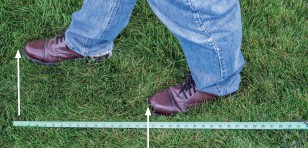 You can calculate square footage by measuring the distance from to the front shoe to the back shoe. “When I practiced, I took five steps and traveled 13 feet. This is 2.6 feet per step.” Thus, 50 steps would be 130 feet (2.6 x 50)
You can calculate square footage by measuring the distance from to the front shoe to the back shoe. “When I practiced, I took five steps and traveled 13 feet. This is 2.6 feet per step.” Thus, 50 steps would be 130 feet (2.6 x 50)
Using Figure 1 to the right as an example, assume that you measure two feet between steps. You then record 78 steps for the length (78 steps x 2 feet = 156) and 44 steps for the width (44 x 2 = 88) for the area you have called Grass 1 (front yard). Next, multiplying length by width to get the square feet for the area (156 x 88 = 13,728 square feet). Finally, record the square footage for this area on your map, like the example in Figure 1 (see Grass 1).
Repeat the process for the other turfgrass areas in your landscape. Using the example in Figure 1, we calculated the areas for Grass areas 2-4. Grass 2 is 90 x 20 steps; Grass 3 is 88 steps x 15 steps; and Grass 4 is 10 x 75 steps. Calculate the square feet in each of the Grass areas based on the steps provided. Do your numbers match those provided in Figure 1?
Now we are ready to tackle the 1,000 square feet measurement part of the equation. The phrase 1 pound of actual nitrogen per 1,000 square feet reminds us that the rates are expressed in 1,000 square foot units instead of square feet.
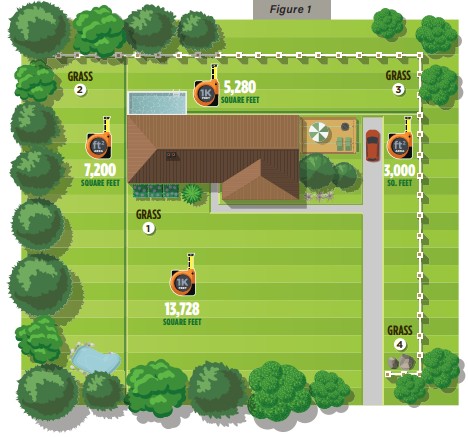 Figure 1
Figure 1 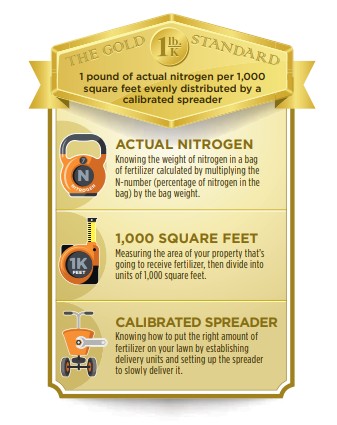
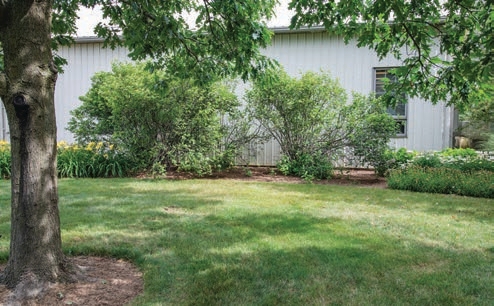 Notice that we do not calculate the square footage of the house, driveway, flowerbeds, or other areas that do not get fertilized.
Notice that we do not calculate the square footage of the house, driveway, flowerbeds, or other areas that do not get fertilized. 
Measuring 1,000 square foot units from square feet is a simple conversion. All you have to do is to divide your total square feet by 1,000 to get how many units of 1,000 are within that green space that needs fertilizer. Write that number down on your map (Figure 2). We can round up or down while doing this step to keep the numbers simple. This will not alter how your grass responds or looks.
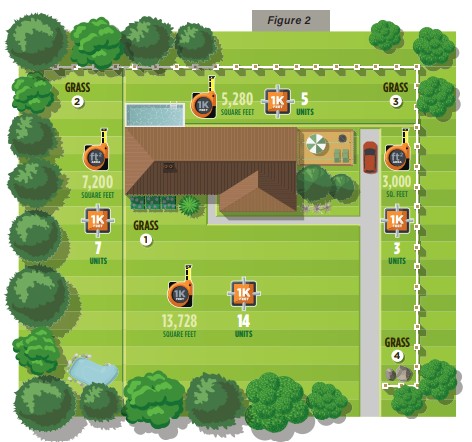
Figure 2
| Area | Square Feet | Number of 1,000 Square-Foot Sections of Turfgrass |
| GRASS 1 | 13,728 | 13.7 or about 14 |
| GRASS 2 | 7,200 | 7.2 or about 7 |
| GRASS 3 | 5,280 | 5.3 or about 5 |
| GRASS 4 | 3,000 | 3.0 |
| Total | 29,208 | 29.2 or about 29 |
An Alternative Method for Getting Lawn Square Feet In the digital age, several online mapping systems are available to measure area via satellite imagery, including:
• Acme Planimeter: acme.com/planimeter
• Map Developers area finder: mapdevelopers.com/ area_finder.php
With these and other tools, you can zoom into the region or type in an address to find your property or get close. Pan around with map view until you find your house and then change to the satellite image layer. Select “draw new area” or a similar tool and draw a border around your front, sides, and back lawns and add them together to get a total. This can be a good method to check yourself if using the above method to see if you get a similar number (plus or minus 10 percent). As a caveat, most imagery used in these web-based tools can be quite a few years old, so newer home lots may not be represented.
The Three Numbers on Fertilizer Bags
You might have noticed that the word actual nitrogen is italicized throughout the publication. This is meant to emphasize that a fertilizer bag that weighs 20 pounds does not contain 20 pounds of nitrogen. The amount of actual nitrogen depends on two factors:
• The percentage of nitrogen in the formulation
• The total weight of the fertilizer bag
When a pound does not equal a pound
One pound of nitrogen is not the same as one pound of fertilizer. So, what does one pound of actual nitrogen mean? Keep reading to find out!
All fertilizer bags list a three-digit formula along with the total weight of the product. The first number represents nitrogen, the second number phosphorus (P2O5, or phosphate), and the third number potassium (K2O, or potash). This is often abbreviated as N-P-K.
Each of the three numbers represents a percentage of the total weight of the bag that contains that nutrient. This fertilizer blend (28-5-10) contains 28 percent nitrogen. The bag weighs 40 pounds. The bag therefore, has about 11 pounds of actual nitrogen (0.28 x 40 = 11.2 pounds). This demonstrates that while the bag is 40 pounds, the amount of actual nitrogen in the bag is about 11 pounds. It also contains 2 pounds of phosphate (phosphorus) and 4 pounds of potash (potassium). Can you figure out how we got the amounts for phosphorus and potassium?
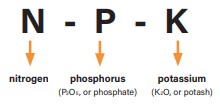
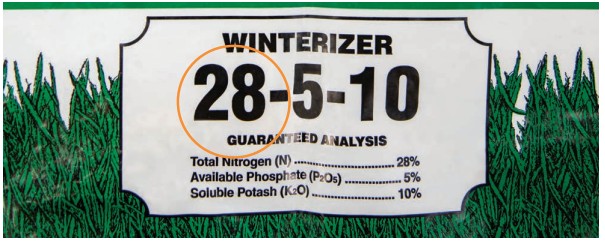 The first number represents nitrogen, the second number phosphorus (P2O5, or phosphate), and the third number potassium
The first number represents nitrogen, the second number phosphorus (P2O5, or phosphate), and the third number potassium 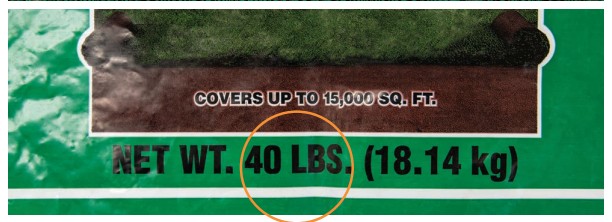
Calculate How Much Actual Nitrogen Is in Each Bag
Answers in approximate pounds of actual nitrogen in bag: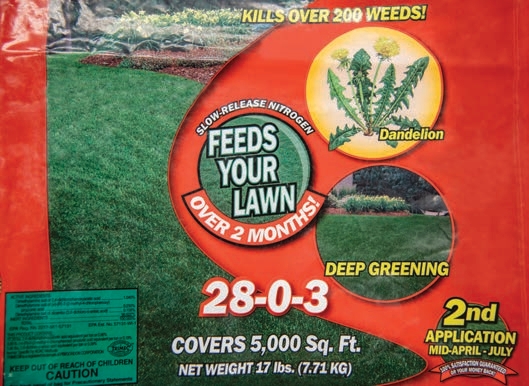 0.28 (%N) x 17 (total weight of bag) = 4.8 pounds of actual nitrogen in the bag
0.28 (%N) x 17 (total weight of bag) = 4.8 pounds of actual nitrogen in the bag 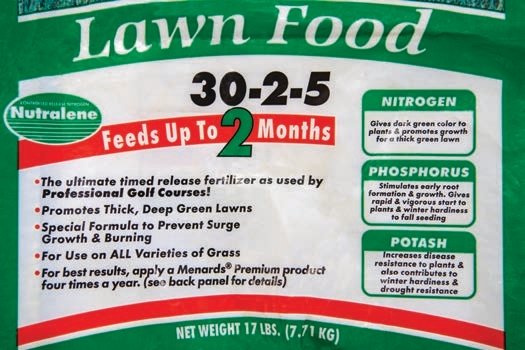 0.30 x 17 = 5 pounds of actual nitrogen
0.30 x 17 = 5 pounds of actual nitrogen 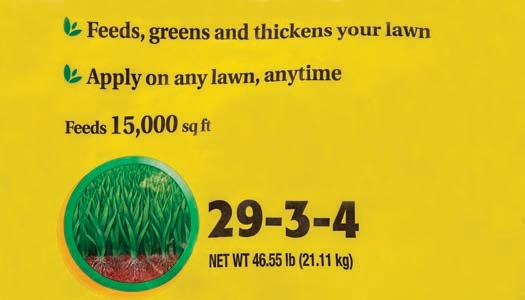 0.29 x 46.55 = 13.5 pounds of actual nitrogen
0.29 x 46.55 = 13.5 pounds of actual nitrogen 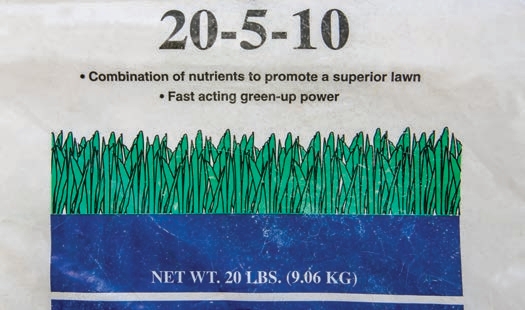
 0.12 x 40 = 5 pounds of actual nitrogen
0.12 x 40 = 5 pounds of actual nitrogen What Did We Learn from These Calculations?
The pounds of actual nitrogen are based on the product’s percentage of nitrogen contained in the bag and the total weight of the bag. If either the weight of the product in the bag or the percentage of nutrient changes, then the amount of actual nitrogen will also change. This means that every fertilizer product will more than likely require its own unique calculations.
Now you know one piece of the information to help you accurately apply 1 pound of actual nitrogen per 1,000 square feet across the target green areas around the home. This effort will help to make a more accurate fertilizer application with minimal water and runoff of the product you purchased.

Actual nitrogen is 13 defined as the weight 0of nitrogen in a bag of fertilizer, not the percentage or N-number.
How Many Bags Will I Need to Purchase?
How many bags of the following two fertilizers would I need to purchase to treat a turfgrass space of 29 units of 1,000 square feet at a rate of 1 pound of actual nitrogen per 1,000 square feet (see table on page 10)?
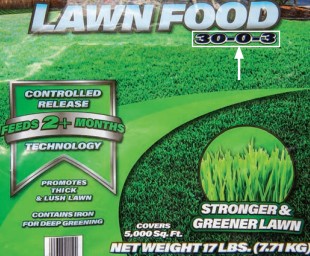 Fertilizer Example 1. The 30-0-3 bag contains nearly 5 pounds of actual nitrogen (0.30 x 17 = 5). This means that each bag can treat 5 units of 1,000 square feet or 5,000 square feet at one pound per 1,000 square feet. Since our 29,000-square-foot turfgrass example has a total of 29 units, that means you will need to purchase six bags to have enough actual nitrogen to cover the total area in our example.
Fertilizer Example 1. The 30-0-3 bag contains nearly 5 pounds of actual nitrogen (0.30 x 17 = 5). This means that each bag can treat 5 units of 1,000 square feet or 5,000 square feet at one pound per 1,000 square feet. Since our 29,000-square-foot turfgrass example has a total of 29 units, that means you will need to purchase six bags to have enough actual nitrogen to cover the total area in our example. 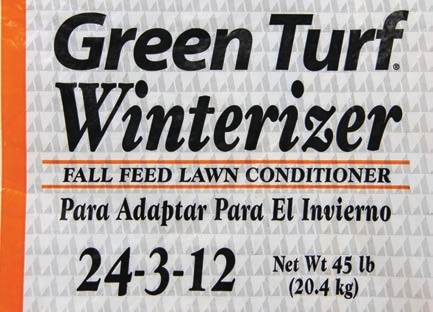 Fertilizer Example 2. The 24-3-12 bag contains 11 pounds of actual nitrogen (0.24 x 45 = 11), so it would take three bags to cover your 29,000-square-foot turfgrass area. You will have some left over from the last bag, which you can save for the next application. Remember: A bag with different weights will have different amounts of nitrogen even if they have the same three-number formula.
Fertilizer Example 2. The 24-3-12 bag contains 11 pounds of actual nitrogen (0.24 x 45 = 11), so it would take three bags to cover your 29,000-square-foot turfgrass area. You will have some left over from the last bag, which you can save for the next application. Remember: A bag with different weights will have different amounts of nitrogen even if they have the same three-number formula. 
Carry your calculator to the store
Calibrating the Spreader to Evenly Distribute Fertilizer

Does this ring true?
Two Commonly Used Spreaders
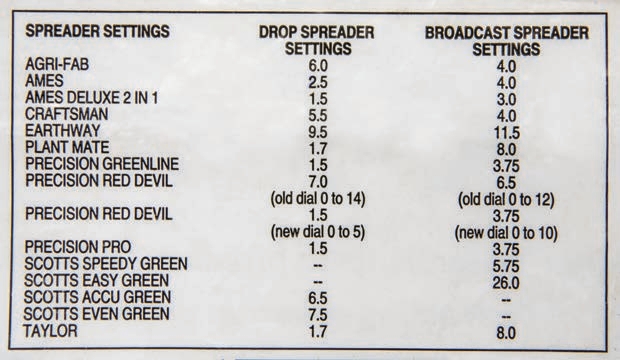

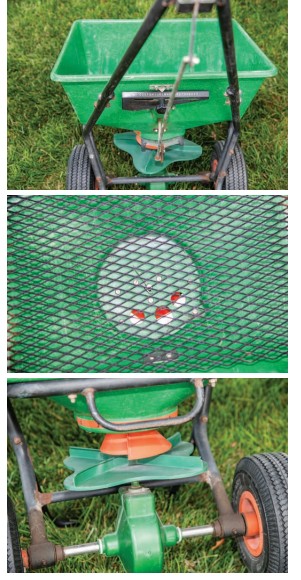 BROADCAST SPREADERS are widely used for fertilizer applications. The fertilizer in the hopper is gravity fed into the center and passes through the gate openings. In this unit, the higher the letter, the greater the openings will be. In other words, if walking at the same speed, the larger openings will throw out more fertilizer than smaller openings. As fertilizer falls through the openings, it encounters a spinning plate that throws the fertilizer around 7 feet out in front and to the sides of the spreader in a semicircular arc. The spinning plate is activated by the turning of the wheel axle as you push the spreader across the treatment area. Broadcast spreaders do not distribute granules uniformly because the spinning plate creates a tapered, fan-shaped pattern. More of the product is distributed in the center of the arc than on either side. This uneven distribution requires that you overlap each pass as you move back and forth across the site. Each pass will be about three steps over from the previous pass. Space your passes to that the fertilizer throws back toward and hits the ground at the wheel tracks of your previous pass. This “wheel-to-wheel” application spacing allows for the correct overlap of the fertilizer and gives your lawn a uniform greening as the fertilizer feeds the turf.
BROADCAST SPREADERS are widely used for fertilizer applications. The fertilizer in the hopper is gravity fed into the center and passes through the gate openings. In this unit, the higher the letter, the greater the openings will be. In other words, if walking at the same speed, the larger openings will throw out more fertilizer than smaller openings. As fertilizer falls through the openings, it encounters a spinning plate that throws the fertilizer around 7 feet out in front and to the sides of the spreader in a semicircular arc. The spinning plate is activated by the turning of the wheel axle as you push the spreader across the treatment area. Broadcast spreaders do not distribute granules uniformly because the spinning plate creates a tapered, fan-shaped pattern. More of the product is distributed in the center of the arc than on either side. This uneven distribution requires that you overlap each pass as you move back and forth across the site. Each pass will be about three steps over from the previous pass. Space your passes to that the fertilizer throws back toward and hits the ground at the wheel tracks of your previous pass. This “wheel-to-wheel” application spacing allows for the correct overlap of the fertilizer and gives your lawn a uniform greening as the fertilizer feeds the turf. 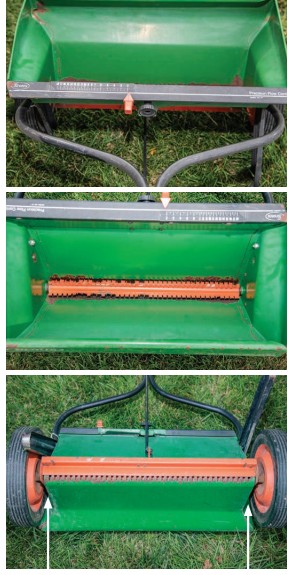 DROP SPREADERS can also apply dry fertilizers. The fertilizer product is poured into a hopper mounted between the wheels. At the bottom of the hopper is a rotating agitator bar, which stirs the product and keeps it flowing freely and uniformly. The agitator bar is driven by the movement of the spreader’s wheels. The fertilizer falls through the adjustable gate openings. The amount of product that falls through the gate is governed by adjusting the openings according to the numbers or letters on the unit. In this example, a larger number produces larger openings for the fertilizer to fall through. Notice in the bottom photograph (white arrows) that the gate openings are inside of the wheels. It is important to make the next pass with the wheel slightly on the inside of the previous pass (see the wheel tracks, previous page). Failure to do so will mean a gap where fertilizer will not be applied, leading to streaking in the turf. Fertilized turfgrass will be dark green, while turfgrass without the added nitrogen will be light green.
DROP SPREADERS can also apply dry fertilizers. The fertilizer product is poured into a hopper mounted between the wheels. At the bottom of the hopper is a rotating agitator bar, which stirs the product and keeps it flowing freely and uniformly. The agitator bar is driven by the movement of the spreader’s wheels. The fertilizer falls through the adjustable gate openings. The amount of product that falls through the gate is governed by adjusting the openings according to the numbers or letters on the unit. In this example, a larger number produces larger openings for the fertilizer to fall through. Notice in the bottom photograph (white arrows) that the gate openings are inside of the wheels. It is important to make the next pass with the wheel slightly on the inside of the previous pass (see the wheel tracks, previous page). Failure to do so will mean a gap where fertilizer will not be applied, leading to streaking in the turf. Fertilized turfgrass will be dark green, while turfgrass without the added nitrogen will be light green. Conceptually, this is easy to visualize. The gate opening and walking speed are the two things that affect the application rate. The faster you walk, the less fertilizer will be put out given the same spreader opening. Larger spreader openings result in more fertilizer applied. The spreader’s setting and application speed are equally important. It seems a daunting and unsolvable task, but understanding a few basic concepts will help provide you a workable solution. Let’s continue with our example in which you need about 29 pounds of actual nitrogen to fertilize a 29,000-squarefoot turfgrass area.
Using a 12-12-12 fertilizer in a 40-pound bag, we calculated the bag has about 5 pounds of actual nitrogen. You purchase six bags of the product to apply the recommended rate of 1 pound of actual nitrogen per 1,000 square feet (5 pounds N x 6 bags = 30 pounds N). To help prevent under- and overapplication, consider the following example in Figure 3. You have six bags, and each bag will cover five units of 1,000 square feet. Divide up the bags based on nitrogen across the turfgrass areas. Place three bags of the product on the site you have identified as Grass 1. The remaining areas (2, 3, and 4) will need 1.5, 1, and 0.5 bags. Use a couple of 5-gallon plastic buckets to hold and place the partial bags. Using this approach, you know exactly how much fertilizer to put down in each area.
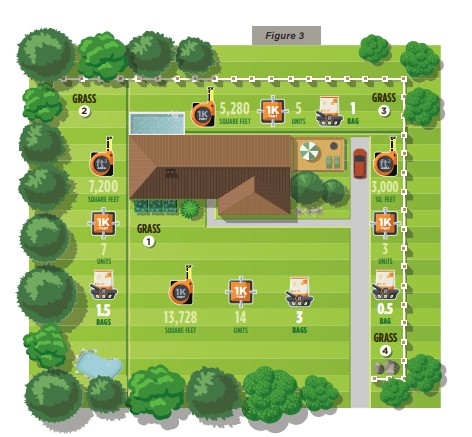
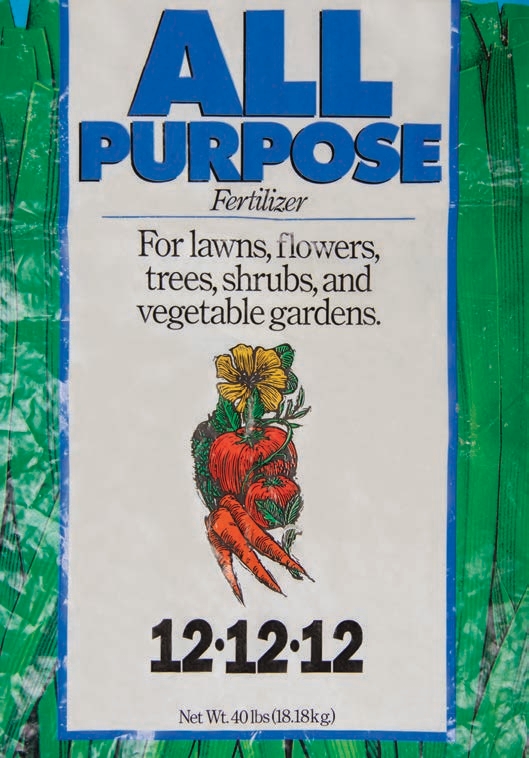
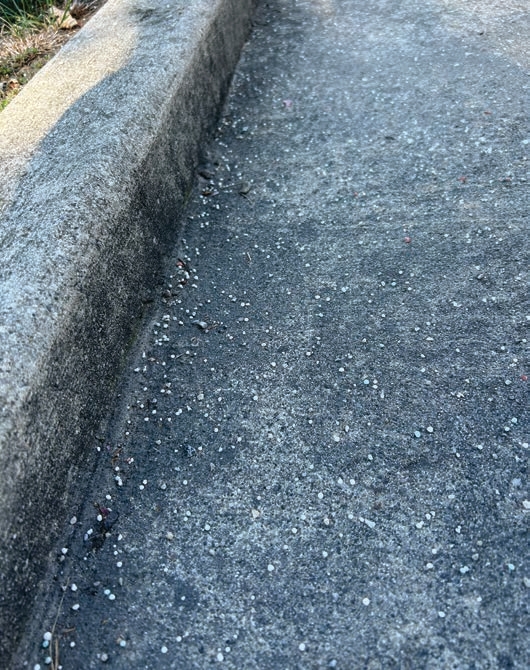 Always pour and measure fertilizer into buckets or your spreader over a hard surface such as pavement. This allows you to easily clean up spills. Spilling fertilizer in the lawn can cause dead spots. After applications, be sure to clean up products that are on sidewalks, driveways, and roads using a broom or blower.
Always pour and measure fertilizer into buckets or your spreader over a hard surface such as pavement. This allows you to easily clean up spills. Spilling fertilizer in the lawn can cause dead spots. After applications, be sure to clean up products that are on sidewalks, driveways, and roads using a broom or blower. Next, adjust the gate setting so the product comes out slowly, which means the gate setting will be slightly open. As a starting point, turn the setting about ¼ of the way open. You can practice on a short section of your driveway using the spreader with fertilizer to see how fast it is being spread. If it looks like too little or too much fertilizer is coming out, then adjust the lever on the spreader.
Remember that this setting is only good for that specific fertilizer based on the shape and size of the dry granules being applied. If you are using a broadcast spreader, this is also the opportunity to gauge just how much the spreader throws in each direction to know how much space to add between passes. Use the wheels to gauge space between passes. Applying with a smaller gate opening gives you time to cover your area without running out. Go over the turfgrass in a north to south pattern, then go east to west to get the material evenly applied and distributed over the turf. Repeat the process until you run out.
Ideally, you will cover the area at least twice in separate directions. It may take you three or four passes in the first section to apply the allotted fertilizer. While it will take you a little longer to complete the application, the end result is an even distribution. If it takes three or more passes to travel over a lawn section to spread the fertilizer, you can slightly increase the gate opening size before you start the next section.
Does this example conjure up thoughts of past applications?
You are spreading the fertilizer, and you realize you are running out quicker than you anticipated. You speed up to get the remainder left in the spreader out over a much larger area. This uneven application means the turfgrass was overfed at the beginning of the application and underfed at the end when you started walking faster.
It should raise a red flag when you run out of fertilizer before you finish covering an area. This means your speed was slower than you practiced and/or the gate setting was opened too much. Speeding up slightly is always an easier approach than trying to reset the gate position. However, it is always better to make more passes than to apply too heavily and run out before you cover the entire area. Clean up any spills that do not land on turfgrass (sidewalks, driveways, and roads).
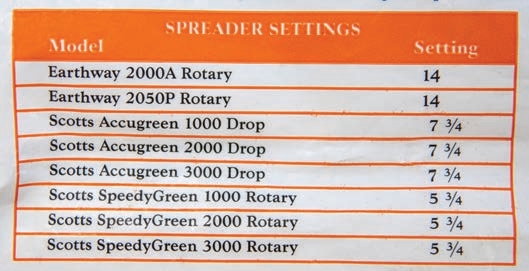
What should you do if your spreader is not listed on the fertilizer bag? The method we presented is an easy way to overcome not having the settings to adjust your spreader.
Customizing Your Process for the Perfect Application
Congratulations! You now understand what it means to deliver 1 pound of actual nitrogen per 1,000 square feet evenly distributed. Customize your fertilizer application by completing the steps below. If you have any problems, just refer to the previous discussion in this publication. Let’s review the eight steps to help you deliver 1 pound of actual nitrogen per 1,000 square feet evenly distributed.
Step 1. Outline the Property (Once Only)
Draw a simple map of your property including house, sheds, sidewalks, driveways, flower beds, patios, decks, and turf.
Step 2. Calculate How Many Feet Are in One Step (Once Only)
Step 3. Measure Each Turfgrass Area (Once Only)
Step 4. Figure Out How Much Fertilizer to Buy (Repeated Each Time)
Once you know how much actual nitrogen you will need to apply, determine how much actual nitrogen is in each bag. You will need to recalculate each time you purchase a new fertilizer bag with a different nitrogen percentage or weight.
Step 5. Calculate Fertilizer Needs for Each Area (Repeated Each Time)
Determine how much fertilizer you need for each area based on 1 pound of actual nitrogen per 1,000 square feet.
Step 6. Place The Amount in Each Area (Repeated Each Time)
Place the amount of fertilizer product you need for each area into buckets and place them in each area.
Step 7. Start with a Small Gate Opening (Repeated Each Time)
When applying, set your spreader with a small gate opening and spread the fertilizer over each area. Remember, you may need more than one pass to distribute the fertilizer evenly.
Step 8. Clean Up (Repeated Each Time)
After applying fertilizer, be sure to sweep or blow off any fertilizer on hardscape back into the lawn.
Step 9. Take Notes to Make Future Applications Easier (Repeated Each Time)
Record spreader settings and take notes including, the fertilizer brand and its analysis to make future applications easier.
Blow It Back in the Yard!
Fertilizer polluting streams, waterways, and other water sources is a real concern. Repeated studies have shown that applying fertilizer to lawns in the correct amount reduces this potential source of pollution. Impervious surfaces (such as sidewalks, driveways, streets, parking lots, and other hardscapes) increase stormwater runoff to storm sewers, which flow to natural water resources like streams, rivers, and lakes (bringing any fertilizer left on those impervious surfaces along with it).
To keep fertilizer out of waterways, use a blower (or broom) and simply make a loop around any impervious surfaces to blow or sweep the fertilizer back in the lawn. Do this even if you don’t think any fertilizer made it to the concrete, because more than likely, some did. As an added incentive, remember that you paid for the fertilizer, so put it to good use in your lawn and do not waste it by letting it run off from your driveway.
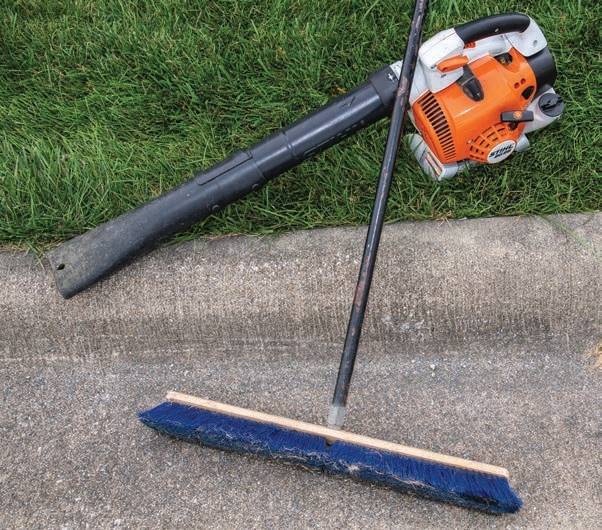
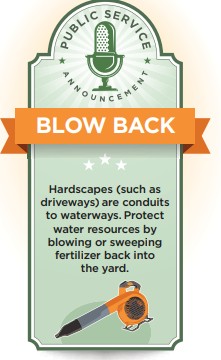
Conclusion
Properly fertilized lawns can provide healthy turfgrass for recreation and can nicely frame residences. Proper fertilizing can also reduce the need for herbicides to control weeds. Fertilizing your lawn is a bit like cooking your favorite recipe. The final product might be unrecognizable if you miss a single ingredient, measure incorrectly, or use the wrong temperature. Similarly, if you do not apply enough nitrogen on the turfgrass, your lawn may show little response, meaning you wasted both time and money. “Hit and miss” applications may mean weakened turfgrass might suffer additional setbacks from weeds, insects, diseases, drought, and traffic. Hopefully, you now understand the important facts behind the recommendation of 1 pound of actual nitrogen per 1,000 square feet evenly distributed by a calibrated spreader. While this is the go-to recommendation, understanding bag size, formulation percentages, square footage, and spreader calibration all come to play when trying to put the right amount of fertilizer on turf. By following the easy-tofollow steps outlined here, your turfgrass will respond in ways you never imagined.
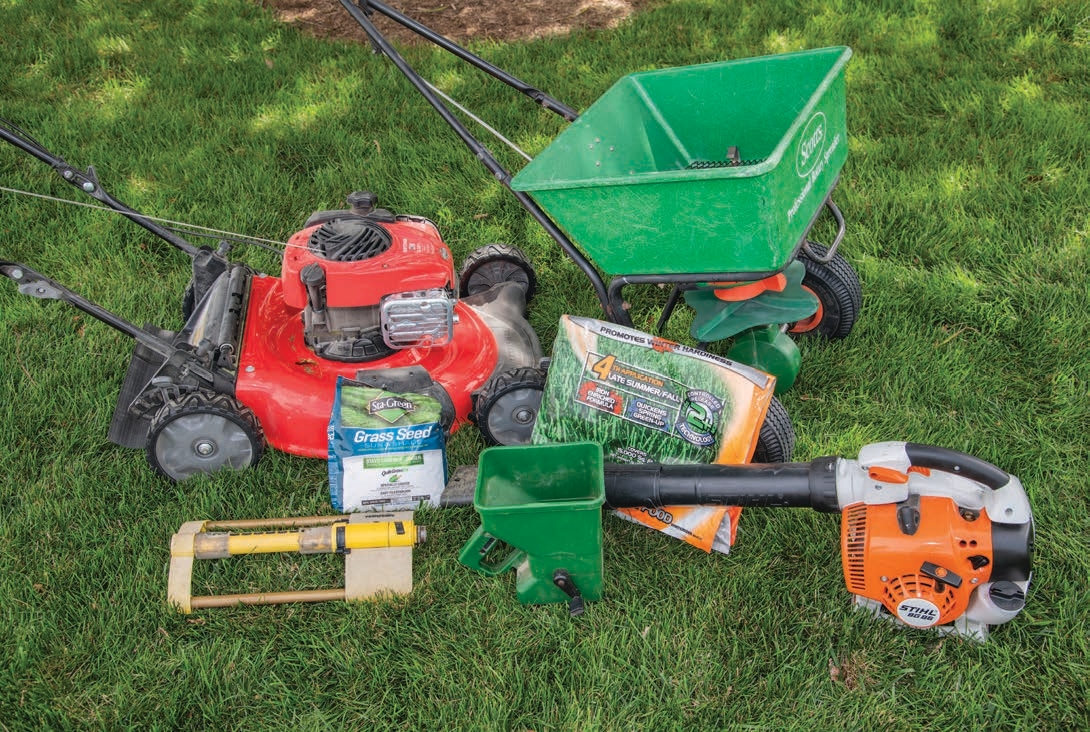
Establishing beautiful turfgrass around your property is possible if you are willing to put in the work. Mowing at the right height, planting the right variety, keeping the turfgrass well-watered, and applying the proper rate of fertilizer at the right time all go together to produce a healthy and beautiful turfgrass stand. Do not forget to sweep or blow fertilizer granules on driveways and sidewalks back into the turf to keep the product out of surface water.
1 POUND OF ACTUAL NITROGEN PER 1,000ft2
Lawn success depends on a perfect balance of measurement, calibration, and calculation

Refer Below worksheets
WORK SHEET (Property Information)
WORK SHEET (Fertilizer and Spreader Information)
Acknowledgements
Thanks to Dawn Minns for graphic design and Adduci Studios for illustrations. Thanks to the following individuals who provided valuable comments and suggestions that improved this publication.
Leslie Beck, New Mexico State University
Becky Bowling, University of Tennessee
Dave Gardner, The Ohio State University
Glenn Hardebeck, Purdue University
Jeff Hermesch, Purdue University
Mark Shaw, Knox Fertilizer Company
DISCLAIMER This publication is intended for educational purposes only. The authors’ views have not been approved by any government agency, business, or individual and cannot be construed as representing a perspective other than that of the authors. The publication is distributed with the understanding that the authors are not rendering legal or other professional advice to the reader, and that the information contained herein should not be regarded or relied upon as a substitute for professional consultation. The use of the information contained herein constitutes an agreement to hold the authors, companies, or reviewers harmless for liability, damage, or expense incurred as a result of reference to or reliance upon the information provided. Mention of a proprietary product or service does not constitute an endorsement by the authors or their employers. Descriptions of specific situations are included only as hypothetical case studies to assist readers of this publication and are not intended to represent any actual person, business entity, or situation. Reference in this publication to any specific commercial product, process, or service, or the use of any trade, firm, or corporation name is for general informational purposes only and does not constitute an endorsement, recommendation, or certification of any kind by Purdue University. Individuals using such products assume responsibility that the product is used in a way intended by the manufacturer and misuse is neither endorsed nor condoned by the authors nor the manufacturer.
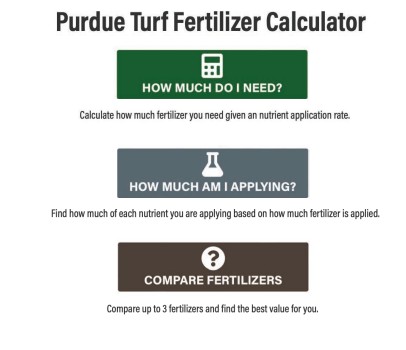 The Purdue University Turfgrass program has developed a “plug the numbers in” calculator that will help you through the math process. We thought it was important that you understand how to do the math before using the calculator. Purdue Turf Calculator — turf.purdue.edu/ fertilizer-calculator
The Purdue University Turfgrass program has developed a “plug the numbers in” calculator that will help you through the math process. We thought it was important that you understand how to do the math before using the calculator. Purdue Turf Calculator — turf.purdue.edu/ fertilizer-calculator 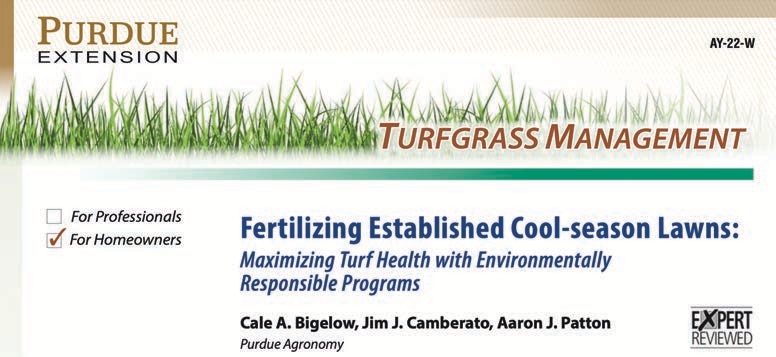 For more information about fertilizing your lawn, including which seasons to make applications, see Fertilizing Established Cool-season Lawns: Maximizing Turf Health with Environmentally Responsible Programs (Purdue Extension publication AY-22-W) available from the Purdue Extension Education Store, edustore.purdue.edu.
For more information about fertilizing your lawn, including which seasons to make applications, see Fertilizing Established Cool-season Lawns: Maximizing Turf Health with Environmentally Responsible Programs (Purdue Extension publication AY-22-W) available from the Purdue Extension Education Store, edustore.purdue.edu.